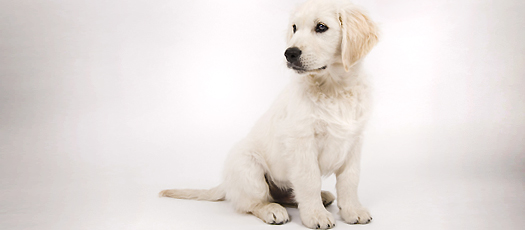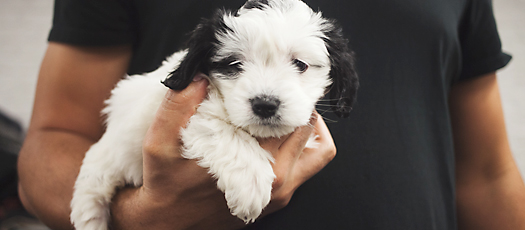
Your puppy – settling in and the socialization process
You can probably hardly wait to pick up the new addition to your family from the breeder. Finally, the big day arrives. Your bundle of fluff can move in! Although the puppy is entering a completely new environment, most young dogs are calm and inquisitive as they explore their new environment. That is especially true if the breeder has raised them as one of the family and given them enough contact with people and environmental stimuli.
A very special time
When you pick up your puppy, he is in an important developmental stage, one that starts in about the third week of life and continues until about the end of the fourth month. This is the socialization phase, and the end of this phase also marks the end of puppyhood. What puppies learn during this time has especially lasting effects. In nature, this is the time when a dog’s wild relatives get to know the other members of the pack and practice communication and communal living. They also spend a lot of time and energy on exploring their habitat, forming an impression of their world. All that is important to ensure their survival.
The same is ultimately true of puppies. During this time, they get to know the people around them and learn certain rules, and they have to be familiarized with their new environment. This process is not the same for all dogs. A “normal family dog” leads a different life than a dog that lives mainly on a farm, for example, or a hunting dog that works primarily in forests and fields or a sheepdog that moves from place to place with a shepherd and herd of sheep.
For your puppy to get used to your shared environment, it’s important to use these first few weeks to gradually build familiarity with the new surroundings.
The first few days
When your puppy first moves into his new home, give him some time and space to get acclimated. The first few days should be limited to getting to know the new family and new home. Visits from friends and family and activities with the little one can wait a few days. You can also take your time and get to know your cuddly new family member. Is he more independent, or highly fixated on his people? Does he explore his new home enthusiastically, or is he more cautious, preferring to take his time? The better you get to know your puppy, the easier it will be for you to make sure new impressions aren’t overwhelming.
Let’s go!
As soon as you feel that your youngster has settled in, he’s ready for something new. You can tell that this is the case if you see that your puppy is relaxed in the new surroundings and if he is eating well and connecting with you. This takes about a week.
Socializing with people
Now it’s time to get to know new people. But not in a large group at first. One or two at a time is perfect. Be sure to take your puppy’s individual nature into account. Depending on the breed, past experiences – or lack thereof – with the breeder, and individual temperament, your puppy may be happy to meet new people, or he may be less interested or even shy. To ensure that all of your pup’s associations with people are positive ones, it’s important to make sure these initial contacts are calm ones. It’s best if the person crouches or kneels and calls the puppy over. If the little one waggles over happily, the person can feel free to pet or cuddle him. However, if your puppy is not interested or is shy, you shouldn’t force the issue. In many cases, it can help to simply wait and not look directly at the puppy. These dogs will often come on their own if curiosity wins out.
There are a couple of things that are generally bad for puppies. Try to keep people, especially children, from running toward them in their excitement, especially if they are also being loud. It is also uncomfortable for dogs when people bend over them and touch or grab them from above.
Your everyday activities will determine how much contact your puppy has with people outside the family. Always be sure that you aren’t overwhelming him. If you have children visiting, for example, they can meet the puppy for a short time under your supervision, but not play and romp around with him for a long time.
Socialization with the environment
What is your everyday life like? The “normal” family dog will tend to accompany his people, whether on walks, to the city, or to a bar or restaurant. For all of this to become part of normal life for your dog, you should get him used to these situations bit by bit. Carry him to the bus, for example, and ride into the city with him. You can sit down at a café with sidewalk seating there and let your puppy take in his surroundings, and then go back home. If you take a trip like this, make sure your puppy isn’t tired, but also isn’t necessarily bursting with energy. Choose a quiet time and a calm place, not necessarily rush hour. A café in a pedestrian area is best.
Or you might go for a pizza dinner with the family. That doesn’t take as long as something like a five-course meal. If you are going to a bar or restaurant, it is a good idea to tire your puppy out a bit beforehand so it is easier for him to get used to “doing nothing.” Take his blanket along, choose a quiet corner to sit in, and leash the dog to a chair or table leg.
Excursions involving longer walks are still a no-no, since the puppy’s joints and ligaments are not yet developed enough to handle unilateral movements. A few minutes at a time is enough to start out with. You can gradually extend the time to about half an hour by the time the dog is five or six months old.
Socializing with other dogs
Your puppy has already practiced being around other dogs with his “dog family,” but even after that, contact with other dogs is still important. Dogs look very different from each other, and not all of them act the same, either. Deliberately seeking contact with other dogs helps your puppy build experience and practice getting along, dog to dog.
When you do this, though, be sure to take your dog’s individual nature into consideration. A reserved or shy puppy needs to be around individual calm, friendly dogs. If you have an active rascal, a self-confident, agreeable and poised dog that isn’t shy about signaling the puppy to stop is a suitable partner. Do not let your puppy romp around with a bigger dog! Larger dogs are much stronger, and your puppy can even seriously hurt himself.
Thinking about a puppy group? That’s a good idea, if you keep a couple of things in mind. The puppies should be a good fit in terms of age and size. There should also be a maximum of six puppies in the group. In a puppy group, as elsewhere, care should be taken to make sure a shy puppy is not overwhelmed, for example. For a puppy like that, an individual, gentle puppy is the right play partner at first. It’s important to make sure the group does more than just play. Puppy groups should also focus on early training.
The myth that puppies enjoy special protection
Many people still think dogs are always friendly toward other dogs up to the age of six months. That is not the case. In nature, our dogs’ wild relatives do care extensively for their own young. Pups from outside the pack, though, have very bad luck indeed…
How an adult dog deals with an unfamiliar puppy depends on the dog’s individual nature and experiences. There are dogs that love puppies, dogs that don’t get them at all and don’t know what to do with them, and dogs that don’t like them a bit.

